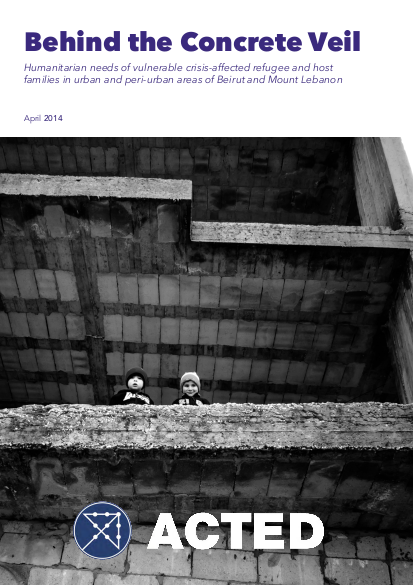
With approximately 5,000 new registrations each week, the Beirut and Mount Lebanon refugee population (close to 148,000 as of the end of March) is the fastest growing in Lebanon, as well as the second largest in the country after Bekaa. This large influx of refugees is having a significant impact on the estimated 2 million Lebanese and 59,000 Palestinian refugees already living in the area prior to the crisis. This is particularly true in impoverished pockets of greater Beirut, where the most vulnerable refugee families and the majority of the estimated 280,000 Lebanese living below the poverty line are concentrated. The aim of this report is to provide an overview of the humanitarian needs faced by vulnerable populations in ACTED’s target areas of Beirut and northern Mount Lebanon (Baabda, Metn, Keserwane and Jbeil Districts). Assessed population groups include not only registered Syrian refugees, but also vulnerable Lebanese families, unregistered refugee households, and refugees registered in other regions but having moved to Mount Lebanon since, whose access to assistance is demonstrably affected by this displacement. Findings are based primarily on household surveys conducted between September 2013 and March 2014, covering a total of 3,657 households, but are qualified by a series of semi-structured focus group discussions and key informant interviews, as well as by a set of programme monitoring and evaluation studies conducted during the same period. While households surveyed were pre-identified based on their expected vulnerability, and so the sample cannot be considered to be statistically representative across the affected population, the large sample size does enable conclusions regarding the situation faced by vulnerable households in target areas. The cost of living was found to be significantly higher in target areas than in the rest of the country, as illustrated by the average monthly cost of rent (320 USD, as opposed to 193 USD nationally). In parallel, with unemployment rates pre-crisis in this region already higher than the national average, limited access to income-generating opportunities has resulted in vast reliance on assistance or negative coping mechanisms such as debt (contracted by over 80% of assessed households) to meet basic needs. This is particularly concerning as findings illustrate a clear correlation between debt, and increased protection, health and hygiene risks. This combination of reduced access to income, and increased expenditure has inevitably affected living conditions of vulnerable families, with a high number living in sub-standard or overcrowded accommodation. Indeed, over 34% of households assessed required upgrading or rehabilitation, and 48% were found to have inadequate or lacking WASH facilities. Furthermore, 36% of assessed households were found to be living with less than 3.5m2 of shelter space per person, and the average number of individuals per shelter was a staggering 7.4. Even in these conditions, a large number of households remain at constant risk of eviction in case of rent payment delays or failures. These poor living conditions severely increase health and hygiene risks faced by assessed populations, as illustrated by the high rates of water contamination identified (40% of assessed water sources with coliform bacteria), as well as poor hygiene despite good hygiene knowledge – whilst 98% of respondents were aware of best hand-washing practices, only 15% occasionally washed their hands, due to limited access to adequate facilities. Assessment findings of vulnerable Lebanese families, though not statistically representative, indicate similar levels of need and vulnerability following the crisis, including in terms of reliance on debt, access to income and living conditions. Despite this, less than 20% of vulnerable Lebanese respondents had received assistance from humanitarian actors. Generally, the perception that Lebanese communities’ needs have been overlooked by humanitarian actors was found to have a profound impact on social cohesion, and on perceptions of host communities with regards to refugees.
Resource collections
- UN Habitat - Urban Response Collection
- Urban Response - Urban Crisis Preparedness and Risk Reduction
- Urban Response Collection - Community Engagement and Social Cohesion
- Urban Response Collection - Economic Recovery
- Urban Response Collection - Environment and Climate Change
- Urban Response Collection - Housing, Land and Property
- Urban Response Collection - Urban Crisis Response, Recovery and Reconstruction
- Urban Response Collection - Urban Resilience